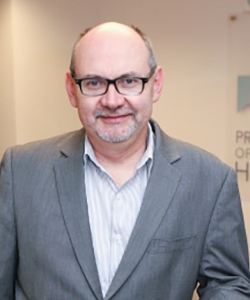Growing without forcing out longtime residents? Woodlawn shows it can be done
Although construction of the Obama Presidential Center is underway and ordinances intended to ensure diversity have been passed, neither the fears nor the debate over the impact of this megadevelopment on adjacent neighborhoods appear to have diminished.
For as much as the OPC investment heralds possible economic growth, it also raises concerns about gentrification and displacement of longtime residents. However, to view the future as a binary choice—revitalization or preservation—overlooks a third, pathway, based on past experience: that of driving growth, while also protecting and expanding opportunities for all.
Over the past decade, Woodlawn has experienced some of the strongest development and growth of any community on the South Side, without significant displacement—an accomplishment that suggests a path for balanced growth.
Filling a demand for new housing in this lakefront community, KMW Communities, an African American-owned for-profit entity, and other local developers have built and sold homes for as much as $700,000—prices unheard of here not so long ago. At the same time, the Preservation for Affordable Housing, or POAH, and other rental housing developers are balancing the equation by protecting and expanding affordable homeownership and rental options. This includes dozens of homes restored and sold affordably and the more than 700 rental apartments POAH built and rehabbed to replace the former Grove Parc Plaza Apartments, as well as its recent purchase of the 240-unit Island Terrace Apartments located directly across from the OPC.
In fact, rather than presenting a threat, we see Woodlawn’s experience as a model of how to create the diverse communities that truly provide opportunity for all—a model whose value we hope will be independently confirmed by a Case Western/University of Illinois study of Woodlawn, slated for release in mid-February.
Following decades of disinvestment, over the last 10 years, Woodlawn has also attracted significant commercial investments, providing residents with new amenities, fresh-food options and jobs—to date, POAH and other developers such as DL3 Realty have built 90,000 square feet of new retail and community spaces a mile west of the OPC, anchored by a new Jewel-Osco grocery store—with more on the way.
The Obama Presidential Center provides an unprecedented opportunity to build on Woodlawn’s assets and the experience of the past decade without fear of displacement—through wise stewardship of available land.
Because 200 or more vacant parcels of land in Woodlawn are owned by the city of Chicago, we have an opportunity to shape development—economic growth and affordability—through wise public policies and a prudent strategy acknowledging that real equity and equality include a commitment to growth.
Abundant land, strong demand for housing, unrivaled access to transit and proximity to one of the nation’s premiere universities set the stage for the repopulation of Woodlawn across the income spectrum—homeowners and renters, long-time residents and newcomers alike.
Some of that planning is already in motion. The Chicago Transit Authority has begun to redo the Green Line Station at 63rd Street and Cottage Grove Avenue to make it a hub of economic and residential activity.
As important, community leaders have long been focused on Woodlawn’s future. The Network of Woodlawn and 1Woodlawn organizations, for example, are critical forums for balancing the need for growth with the need to accommodate existing residents.
Our experience and discussions with neighborhood leaders and residents make clear that Woodlawn residents want both economic growth—new homes, new stores, a revitalized 63rd Street—and protections for lower-income residents, resulting in a neighborhood that is diverse economically and racially.
What is needed in Woodlawn varies. In East Woodlawn, close to the University of Chicago and OPC, the private market is primed toward higher-end homes and condominiums. Here, preserving as many affordable properties as possible is critical to a balanced community, and sales of city-owned land can leverage new affordable units to complement market activity.
West Woodlawn’s story is more mixed. On some blocks, newly built homes are priced in the $500,000 range, but activity is spotty. Nevertheless, hundreds of publicly owned parcels can be targeted for moderate-income home sales through such vehicles as Renew Woodlawn, which uses a variety of public funding sources for affordable homeownership.
63rd Street, running east-west through the heart of Woodlawn, may be the centerpiece for continuing growth. Most, if not all, of the vacant land running 1.5 miles from Stony Island to King Drive is owned by the city, creating the opportunity for a public debate about its development. Getting an underdeveloped 63rd Street right, including the transportation node at its center, can open more opportunities and knit Woodlawn more closely together along a vibrant corridor.
Like the OPC, which is just getting underway, Woodlawn is a work in progress. Its future, too, is being built right now. And with the right public policies and private actors, that future holds the opportunity for growth that serves all of its residents.


